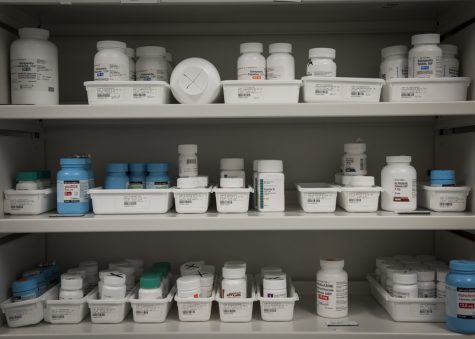Newsom’s proposed drug plan makes state government a pharmacy
Talking to party members, Governor Gavin Newsom advocates for his plan at a Democratic Party fundraiser.
February 6, 2020
On Jan. 9, Gov. Gavin Newsom announced a new initiative to combat rising prescription drug prices by creating a new government-run drug distribution brand. If it is approved by the legislature (first in May and again this summer), California would become the first state to directly compete with private-sector companies in the prescription drug market.
Newsom’s proposal would make significant changes to the scope of the state government’s drug purchasing program and separate it from Medi-Cal. According to the government’s online budget summary, the new system “improves the availability of pharmacy services with a pharmacy network that includes approximately 94 percent of the state’s pharmacies.” This would be done by requiring all generic drug companies selling in California to sell products under special price controls. These new price controls are hoped to strengthen the state’s negotiating power regarding pricing of manufactured generic drugs, according to the California budget website.
California directly purchasing and distributing prescription drugs is not new; it has been common practice under Medi-Cal, the state’s universal health insurance program since 1966. But the new plan works like a private company, not a separate government benefit.
Newsom’s plan would establish the Golden State Drug Pricing Schedule, which requires drug manufacturers to sell their drugs at a uniform price in the California market. The plan also includes a most-favored-nation clause for the manufacturer price bid, meaning manufacturers would have to offer [California] prices at or below the prices offered to other buyers, according to the California budget website.
After negotiating prices with manufacturers, the state government would distribute medications under a government-run brand. Newsom predicts that this approach will “increase competition in the generic market, resulting in lower generic drug prices for all purchasers.”

Awaiting approval, Gov. Newsom’s plan for controlling drug pricing could be enacted in 2021
Paul Ippolito, an AP economics teacher at Redwood, opposes the new strategy for a number of reasons, such as the program’s potential to drive off for-profit businesses.
“Drug companies do something called price discrimination…[they] sell drugs cheaper in poorer countries, [knowing] rich countries would subsidize drug prices,” Ippolito said. “One problem I see here is some drug companies may not even want to sell in California. They may say it’s not worth it because they’d have to lower prices too much, or give other states a price cut.”
Ann Tepovich, another seasoned economics teacher at Redwood, also has questions about the specifics of the plan.
“Obviously, there’d be an enormous amount of startup cost for this, right? This is going to make people question, ‘Do we want [government influence] in this marketplace?” Tepovich said.
The current information made available by the state government in the California budget website does not stipulate what the scale of the new label’s operations would be, nor does it say how its coverage of specific drugs differs from that of Medi-Cal. Ken Ip, a physician who works with Kaiser Permanente, is concerned with how Newsom’s plan could affect the availability of the generic drugs themselves as a result of this move.

Prompted by steadily rising prescription prices, the new drug plan aims to reduce costs and boost availability.
“It could drive [drug] manufacturers out of California, especially if [the government demands] uniform pricing. If that were to happen, how would that affect companies like Kaiser and how they serve their patients?” Ip said.
The same situations that sometimes drive drug manufacturers from California can create medicine shortages for private groups like Kaiser. Although the stated goal of the new program is to increase competition in the generic drug market, the proposed pricing rules could deprive those competitors of Californian suppliers, leaving patients with less choice and possibly higher prices.
“[Kaiser has] had commonly used medications where we placed an order for the drug manufacturer and we couldn’t get it. Then we have to start rationing the medication, and we have to charge people, say, $20 for a one-month supply when they’re normally entitled to three months. So it ends up costing the patients more,” Ip said.
There are many unknowns as to how private companies will react to the points brought up by Ip; no generic drug manufacturer has yet commented on the budget proposals.
For more information about the governor’s new plan, visit the Summary page of ebudget.ca.gov and open the Health and Human Services PDF.





















